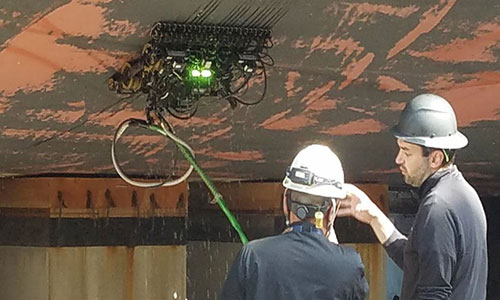ROV Brings New Success to Naval Asset Inspections
 For maintainers working to sustain large assets, such as Naval ships, it’s no longer necessary to perform the laborious, time-consuming work of manual structural assessments, using a hand-held probe, while elevated thirty feet in the air.
For maintainers working to sustain large assets, such as Naval ships, it’s no longer necessary to perform the laborious, time-consuming work of manual structural assessments, using a hand-held probe, while elevated thirty feet in the air.
A CTMA collaboration recently achieved exceptional success by using a remotely operated vehicle (ROV) equipped with ultrasonic testing (UT) capabilities to inspect Naval assets. The initiative, a collaboration between the Office of the Secretary of Defense (OSD) and Gecko Robotics, found that this technology can significantly reduce lead time, man-hours, safety risk, and unscheduled maintenance while improving data quality for maintenance operations.
The team worked in Yokosuka, Japan, at the US Naval Ship Repair Facility and Japan Regional Maintenance Center (SRF-JRMC), using Gecko Robotics’s TOKA wall-climbing ROV to perform visual and UT inspections on two assets: the Dry Dock #4 caisson (the large gate at the harbor end of the dry dock), and the USS Howard, which is part of the Navy’s Seventh Fleet mission.
“Our robotic system is capable of extracting a level of data that is cost-prohibitive or impossible from a manual perspective,” said Will Elliott, Head of Government Sales at Gecko Robotics. “We then utilize that data through a suite of applications. We drive the key maintenance decisions to ensure that assets are operational, in a cost-effective manner.”
The TOKA wall-climbing ROV provides the capability to identify material discontinuities caused by damage mechanisms such as wall-thinning, coating loss, corrosion, pitting, and weld cracking. The ROV’s onboard camera eliminates the need to perform a visual inspection prior to conducting a UT inspection. Further, using the ROV provides multiple improvements over current methods, including faster speed, increased comprehensiveness, and vastly more informative data.
“The level of data that we extract is hundreds of thousands of times greater than the level of data extracted using manual methods,” said Elliott. “Getting that level of fidelity allows you to get a very good baseline understanding of the asset condition to help make better decisions and more targeted repairs.”
For the Dry Dock #4 caisson, the existing non-destructive testing (NDT) inspection of the caisson uses an 8-foot grid pattern across the surface of one side of the caisson and provides less than 100 data points. In contrast, the ROV inspected a majority of the caisson’s B-side, providing over 4.2 million data points. The additional coverage provided by the ROV identified thinning and pitting within the caisson structure not previously identified using existing methods. Using the ROV resulted in a lead time reduction of 77 hours as well as a 213-man-hour reduction.
Employing the ROV for inspections of the USS Howard—specifically the port side of the hull and the outboard side of the starboard rudder—led to even more significant improvements, with a lead time reduction of 288 hours and an 875-man-hour reduction. Before the ROV, the inspection process produced 6,000 data points. The ROV provided significantly more coverage by collecting over 3.3 million data points for the hull and over 463,000 data points for the outboard side of the starboard rudder. This additional coverage identified areas of concern on the rudder for further investigation.
In addition to increased comprehensiveness and speed, Gecko Robotics’ software solution for data management—the Gecko Portal, a cloud-based platform—provided rapid insight for condition-based maintenance. The Gecko Portal produced high-density maps for visual representation of, and interaction with, inspection data using thickness filters and time-based differencing.
“This level of data enables us to produce predictive models using AI and ML to look at trends, degradation, and plan for damage repair before it even happens,” said Elliott. “The data helps to look at assets with a condition-based maintenance mindset, so you can allocate resources in an optimal manner based on where they’re most needed.”
Along with providing better data, this project increased worker safety, as the ROV operation could be conducted at ground level in the dry dock. This eliminated the need for NDT inspectors and recorders to utilize a manlift for fall protection. Using the ROV also reduced environmental impact because the ROV is capable of performing UT inspections through coatings, eliminating the need for coating removal and restoration as well as the associated lead abatement controls.
The technology demonstrated in this project can benefit multiple commercial industries needing to inspect large assets. In particular, energy producers such as oil and gas companies would be able to inspect energy-producing assets without interrupting operations.
“It’s really expensive to be reactive and fix depreciating assets after they fail. If that happens regularly, it’s going to increase the price of power,” said Elliott. “By utilizing our technology and the data we use in our in our software, you can not only ensure that these assets are producing power, but also keep the keep the price down to a reasonable level.”
While the project focused on two Naval assets, it’s clear that it would have broad application to assets across the entire DOD.
“We want to see if we’re able to scale our solution through all the regional maintenance centers,” said Elliott. He noted that further improvements to speed could be made through the use of multiple ROVs operating in parallel. Such dramatic time-saving benefits would have an enormous impact on materiel readiness.
